TOYOTA YARIS HYBRID 2013 Owners Manual
Manufacturer: TOYOTA, Model Year: 2013, Model line: YARIS HYBRID, Model: TOYOTA YARIS HYBRID 2013Pages: 700, PDF Size: 28.68 MB
Page 471 of 700
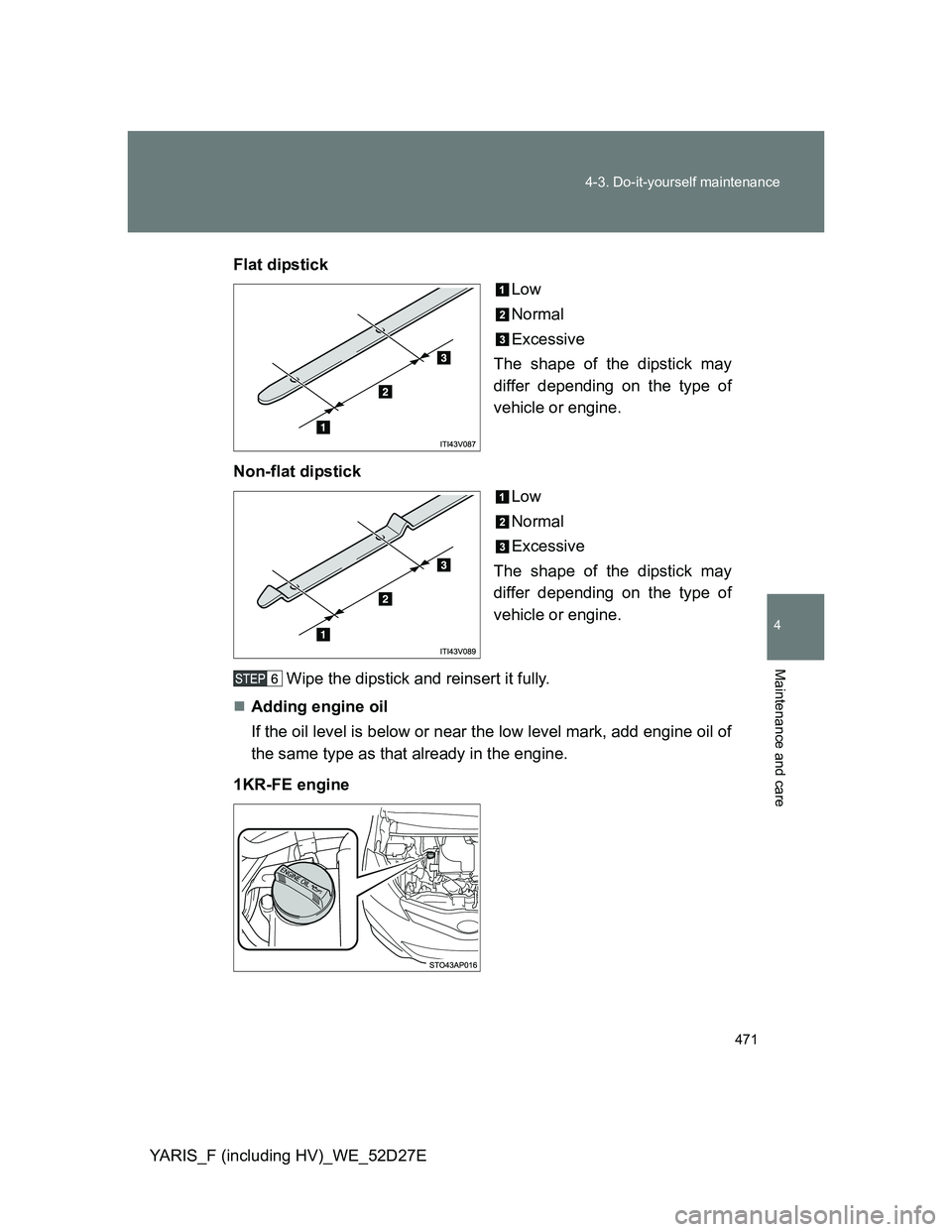
471 4-3. Do-it-yourself maintenance
4
Maintenance and care
YARIS_F (including HV)_WE_52D27EFlat dipstick
Low
Normal
Excessive
The shape of the dipstick may
differ depending on the type of
vehicle or engine.
Non-flat dipstick
Low
Normal
Excessive
The shape of the dipstick may
differ depending on the type of
vehicle or engine.
Wipe the dipstick and reinsert it fully.
Adding engine oil
If the oil level is below or near the low level mark, add engine oil of
the same type as that already in the engine.
1KR-FE engine
Page 472 of 700
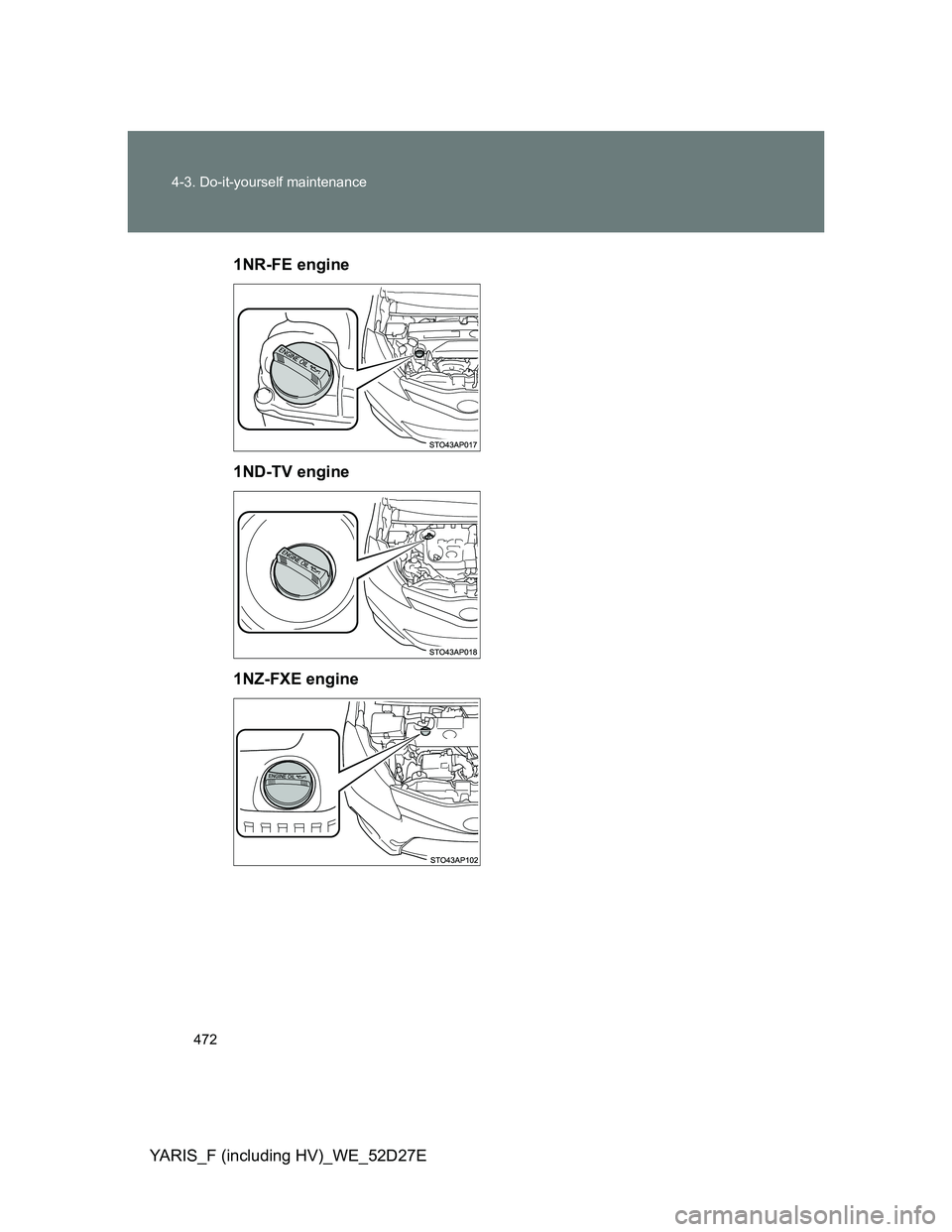
472 4-3. Do-it-yourself maintenance
YARIS_F (including HV)_WE_52D27E1NR-FE engine
1ND-TV engine
1NZ-FXE engine
Page 473 of 700
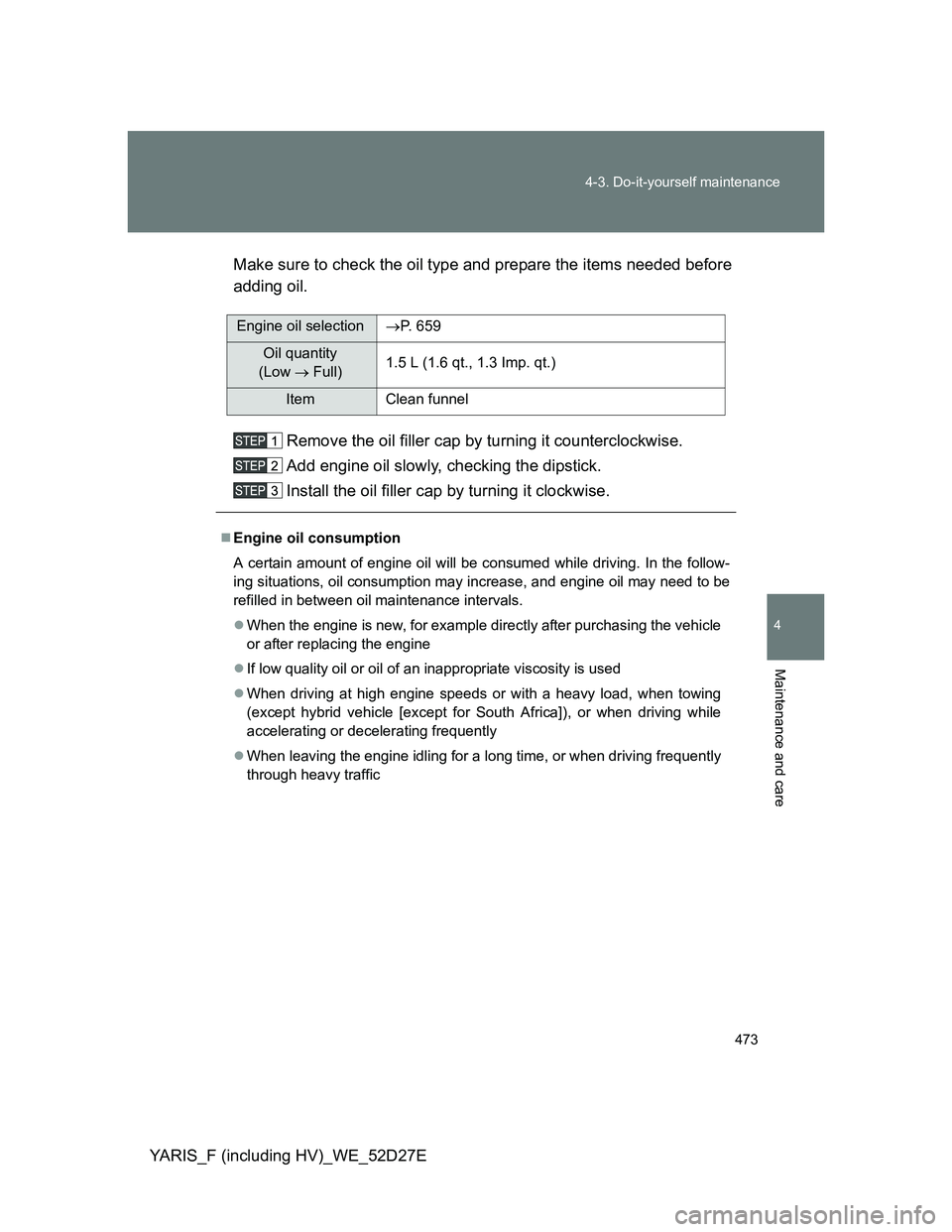
473 4-3. Do-it-yourself maintenance
4
Maintenance and care
YARIS_F (including HV)_WE_52D27EMake sure to check the oil type and prepare the items needed before
adding oil.
Remove the oil filler cap by turning it counterclockwise.
Add engine oil slowly, checking the dipstick.
Install the oil filler cap by turning it clockwise.
Engine oil selectionP. 659
Oil quantity
(Low Full)1.5 L (1.6 qt., 1.3 Imp. qt.)
Item Clean funnel
Engine oil consumption
A certain amount of engine oil will be consumed while driving. In the follow-
ing situations, oil consumption may increase, and engine oil may need to be
refilled in between oil maintenance intervals.
When the engine is new, for example directly after purchasing the vehicle
or after replacing the engine
If low quality oil or oil of an inappropriate viscosity is used
When driving at high engine speeds or with a heavy load, when towing
(except hybrid vehicle [except for South Africa]), or when driving while
accelerating or decelerating frequently
When leaving the engine idling for a long time, or when driving frequently
through heavy traffic
Page 474 of 700
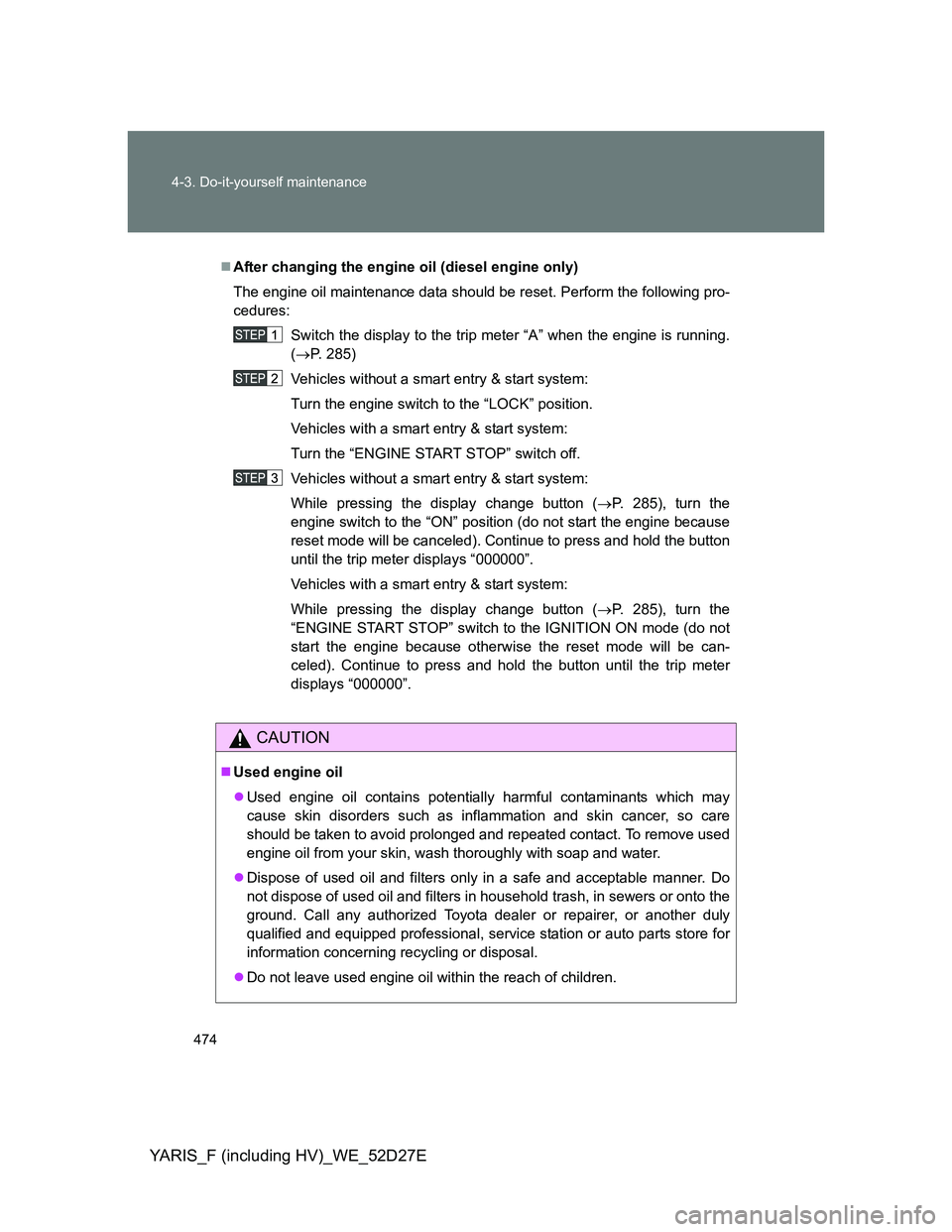
474 4-3. Do-it-yourself maintenance
YARIS_F (including HV)_WE_52D27E
After changing the engine oil (diesel engine only)
The engine oil maintenance data should be reset. Perform the following pro-
cedures:
Switch the display to the trip meter “A” when the engine is running.
(P. 285)
Vehicles without a smart entry & start system:
Turn the engine switch to the “LOCK” position.
Vehicles with a smart entry & start system:
Turn the “ENGINE START STOP” switch off.
Vehicles without a smart entry & start system:
While pressing the display change button (P. 285), turn the
engine switch to the “ON” position (do not start the engine because
reset mode will be canceled). Continue to press and hold the button
until the trip meter displays “000000”.
Vehicles with a smart entry & start system:
While pressing the display change button (P. 285), turn the
“ENGINE START STOP” switch to the IGNITION ON mode (do not
start the engine because otherwise the reset mode will be can-
celed). Continue to press and hold the button until the trip meter
displays “000000”.
CAUTION
Used engine oil
Used engine oil contains potentially harmful contaminants which may
cause skin disorders such as inflammation and skin cancer, so care
should be taken to avoid prolonged and repeated contact. To remove used
engine oil from your skin, wash thoroughly with soap and water.
Dispose of used oil and filters only in a safe and acceptable manner. Do
not dispose of used oil and filters in household trash, in sewers or onto the
ground. Call any authorized Toyota dealer or repairer, or another duly
qualified and equipped professional, service station or auto parts store for
information concerning recycling or disposal.
Do not leave used engine oil within the reach of children.
Page 475 of 700
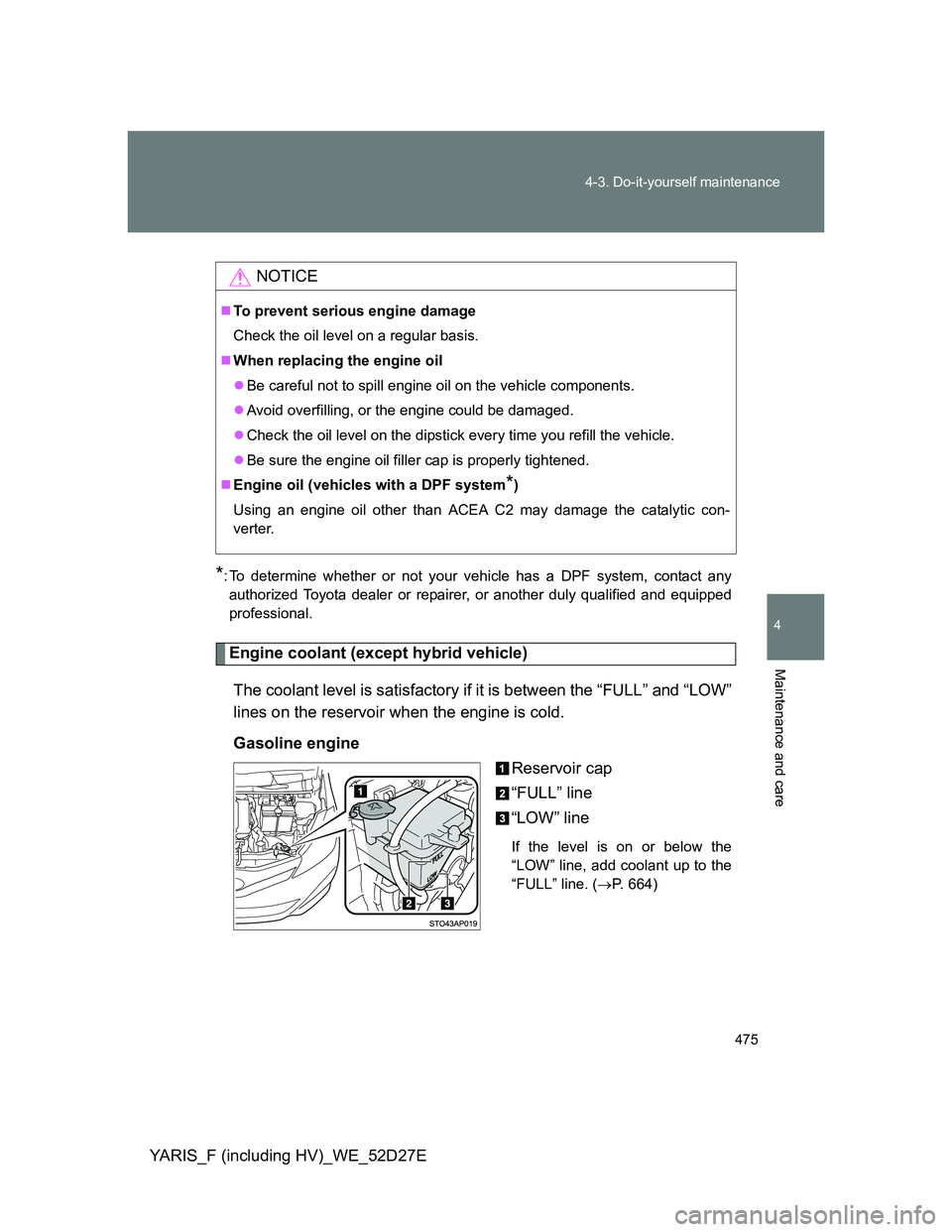
475 4-3. Do-it-yourself maintenance
4
Maintenance and care
YARIS_F (including HV)_WE_52D27E
*: To determine whether or not your vehicle has a DPF system, contact any
authorized Toyota dealer or repairer, or another duly qualified and equipped
professional.
Engine coolant (except hybrid vehicle)
The coolant level is satisfactory if it is between the “FULL” and “LOW”
lines on the reservoir when the engine is cold.
Gasoline engine
Reservoir cap
“FULL” line
“LOW” line
If the level is on or below the
“LOW” line, add coolant up to the
“FULL” line. (P. 664)
NOTICE
To prevent serious engine damage
Check the oil level on a regular basis.
When replacing the engine oil
Be careful not to spill engine oil on the vehicle components.
Avoid overfilling, or the engine could be damaged.
Check the oil level on the dipstick every time you refill the vehicle.
Be sure the engine oil filler cap is properly tightened.
Engine oil (vehicles with a DPF system
*)
Using an engine oil other than ACEA C2 may damage the catalytic con-
verter.
Page 476 of 700
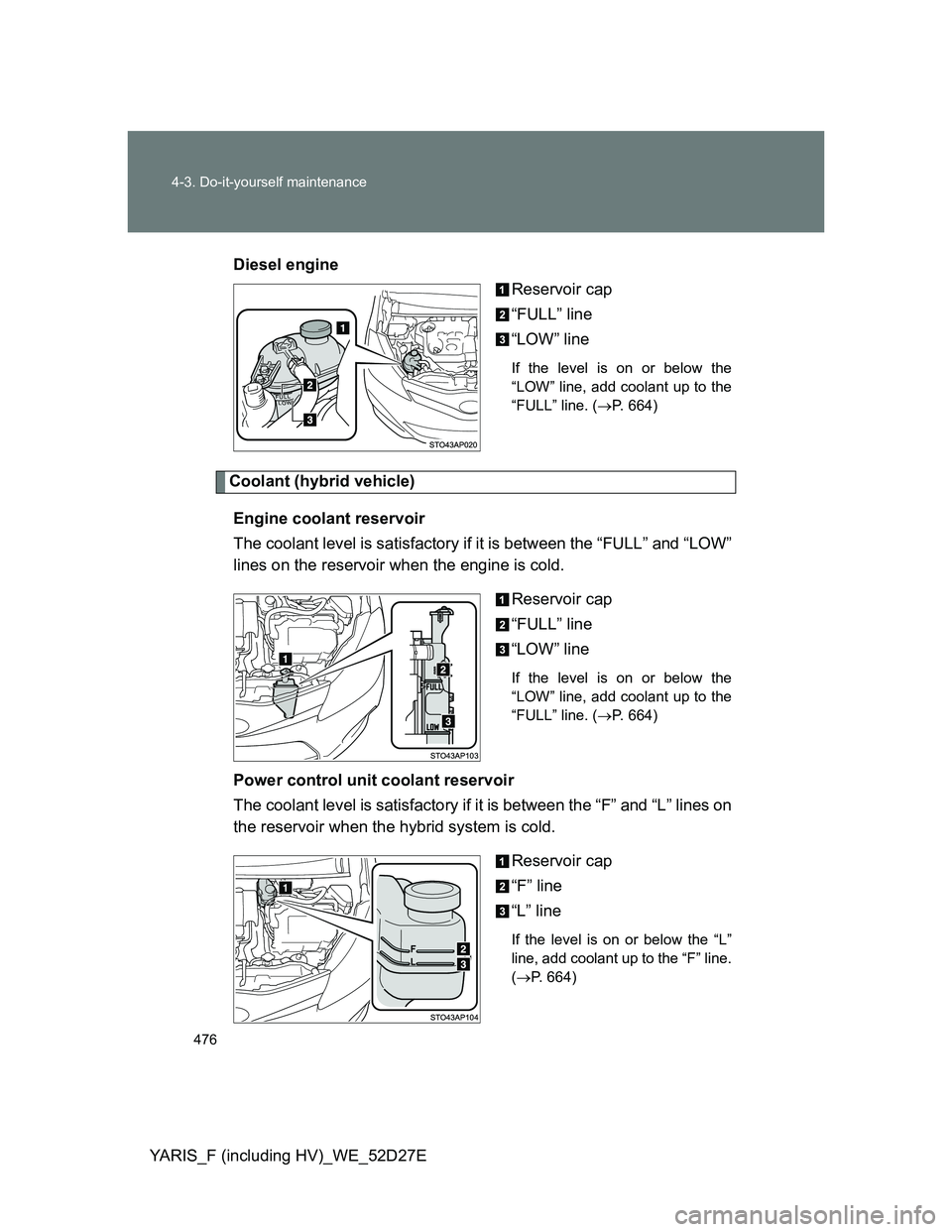
476 4-3. Do-it-yourself maintenance
YARIS_F (including HV)_WE_52D27EDiesel engine
Reservoir cap
“FULL” line
“LOW” line
If the level is on or below the
“LOW” line, add coolant up to the
“FULL” line. (P. 664)
Coolant (hybrid vehicle)
Engine coolant reservoir
The coolant level is satisfactory if it is between the “FULL” and “LOW”
lines on the reservoir when the engine is cold.
Reservoir cap
“FULL” line
“LOW” line
If the level is on or below the
“LOW” line, add coolant up to the
“FULL” line. (P. 664)
Power control unit coolant reservoir
The coolant level is satisfactory if it is between the “F” and “L” lines on
the reservoir when the hybrid system is cold.
Reservoir cap
“F” line
“L” line
If the level is on or below the “L”
line, add coolant up to the “F” line.
(P. 664)
Page 477 of 700
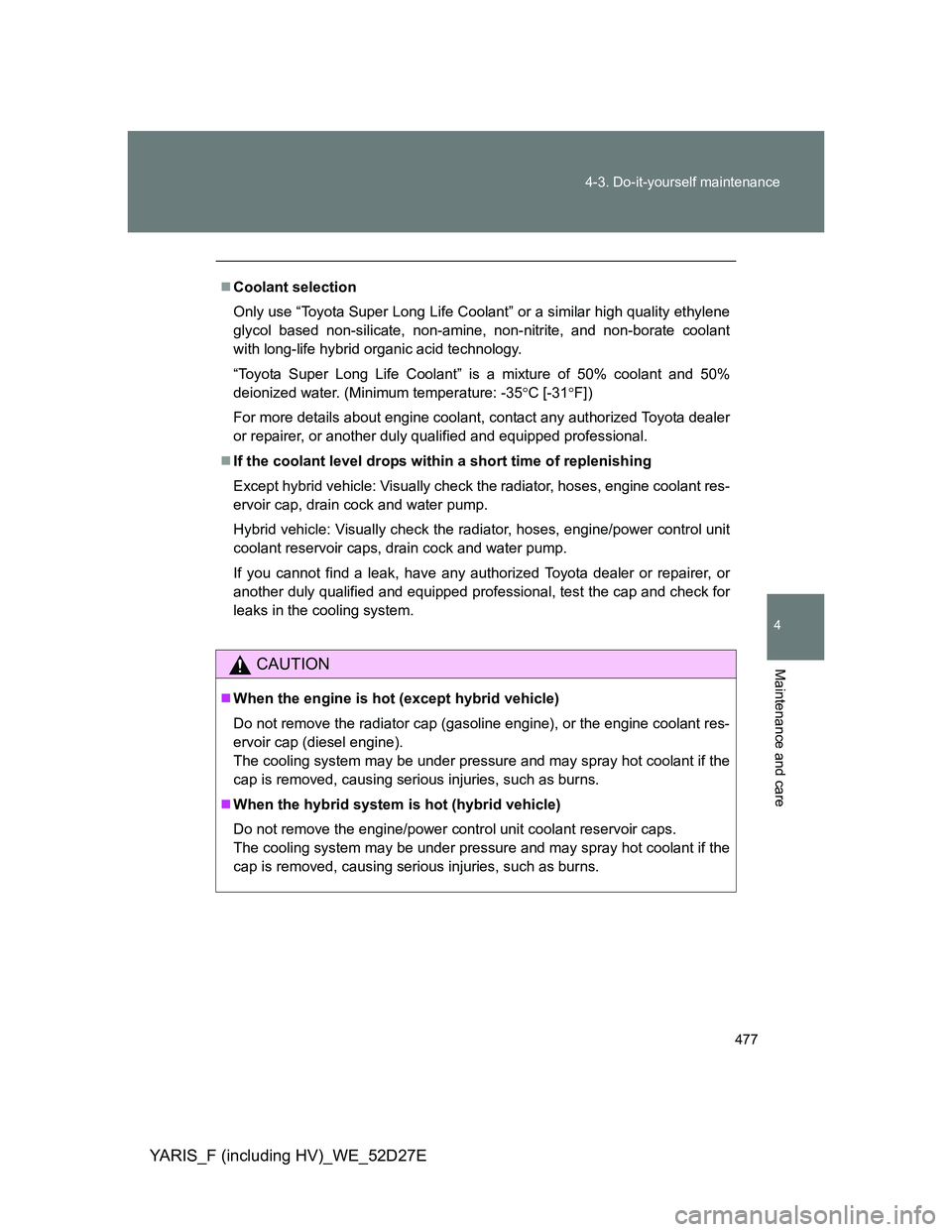
477 4-3. Do-it-yourself maintenance
4
Maintenance and care
YARIS_F (including HV)_WE_52D27E
Coolant selection
Only use “Toyota Super Long Life Coolant” or a similar high quality ethylene
glycol based non-silicate, non-amine, non-nitrite, and non-borate coolant
with long-life hybrid organic acid technology.
“Toyota Super Long Life Coolant” is a mixture of 50% coolant and 50%
deionized water. (Minimum temperature: -35C [-31F])
For more details about engine coolant, contact any authorized Toyota dealer
or repairer, or another duly qualified and equipped professional.
If the coolant level drops within a short time of replenishing
Except hybrid vehicle: Visually check the radiator, hoses, engine coolant res-
ervoir cap, drain cock and water pump.
Hybrid vehicle: Visually check the radiator, hoses, engine/power control unit
coolant reservoir caps, drain cock and water pump.
If you cannot find a leak, have any authorized Toyota dealer or repairer, or
another duly qualified and equipped professional, test the cap and check for
leaks in the cooling system.
CAUTION
When the engine is hot (except hybrid vehicle)
Do not remove the radiator cap (gasoline engine), or the engine coolant res-
ervoir cap (diesel engine).
The cooling system may be under pressure and may spray hot coolant if the
cap is removed, causing serious injuries, such as burns.
When the hybrid system is hot (hybrid vehicle)
Do not remove the engine/power control unit coolant reservoir caps.
The cooling system may be under pressure and may spray hot coolant if the
cap is removed, causing serious injuries, such as burns.
Page 478 of 700
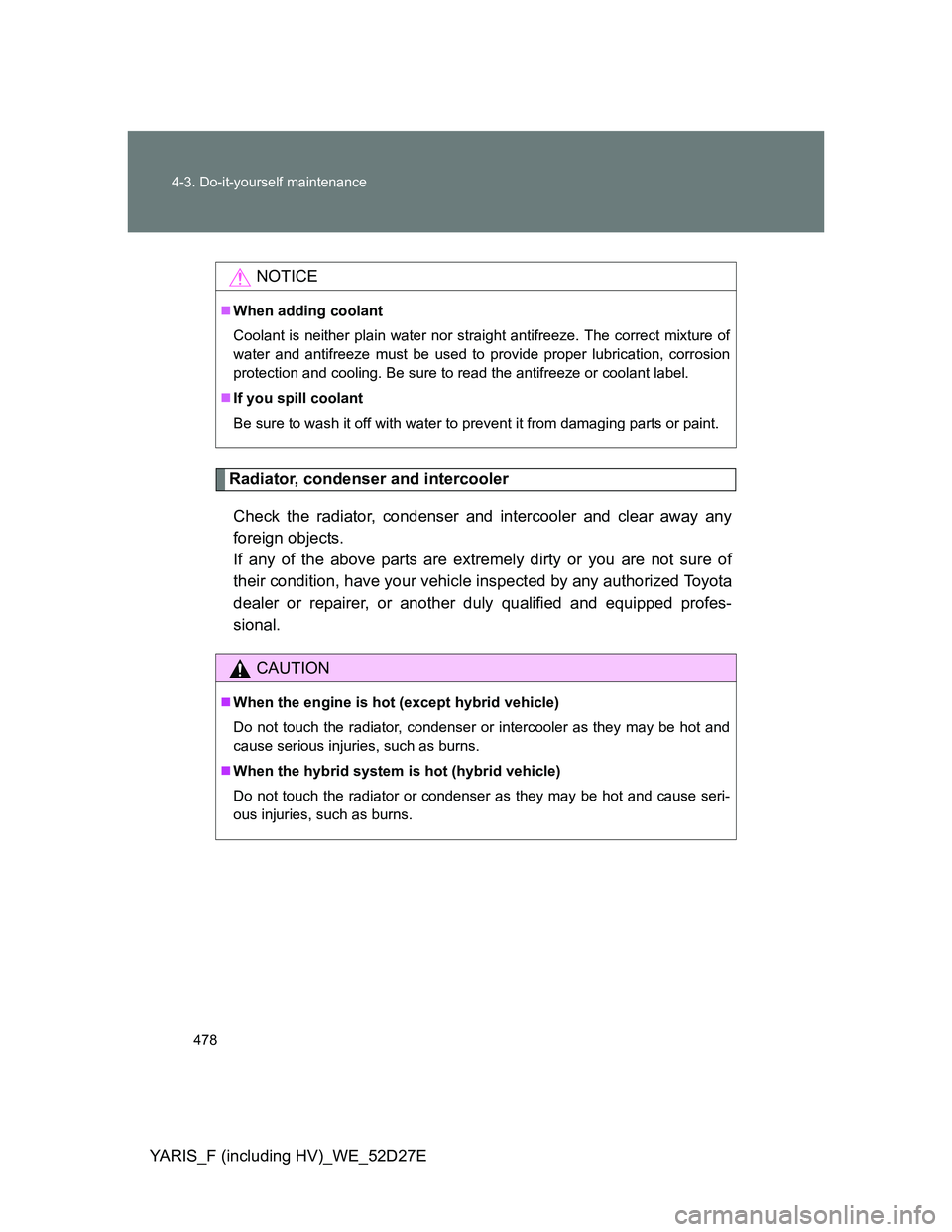
478 4-3. Do-it-yourself maintenance
YARIS_F (including HV)_WE_52D27E
Radiator, condenser and intercooler
Check the radiator, condenser and intercooler and clear away any
foreign objects.
If any of the above parts are extremely dirty or you are not sure of
their condition, have your vehicle inspected by any authorized Toyota
dealer or repairer, or another duly qualified and equipped profes-
sional.
NOTICE
When adding coolant
Coolant is neither plain water nor straight antifreeze. The correct mixture of
water and antifreeze must be used to provide proper lubrication, corrosion
protection and cooling. Be sure to read the antifreeze or coolant label.
If you spill coolant
Be sure to wash it off with water to prevent it from damaging parts or paint.
CAUTION
When the engine is hot (except hybrid vehicle)
Do not touch the radiator, condenser or intercooler as they may be hot and
cause serious injuries, such as burns.
When the hybrid system is hot (hybrid vehicle)
Do not touch the radiator or condenser as they may be hot and cause seri-
ous injuries, such as burns.
Page 479 of 700
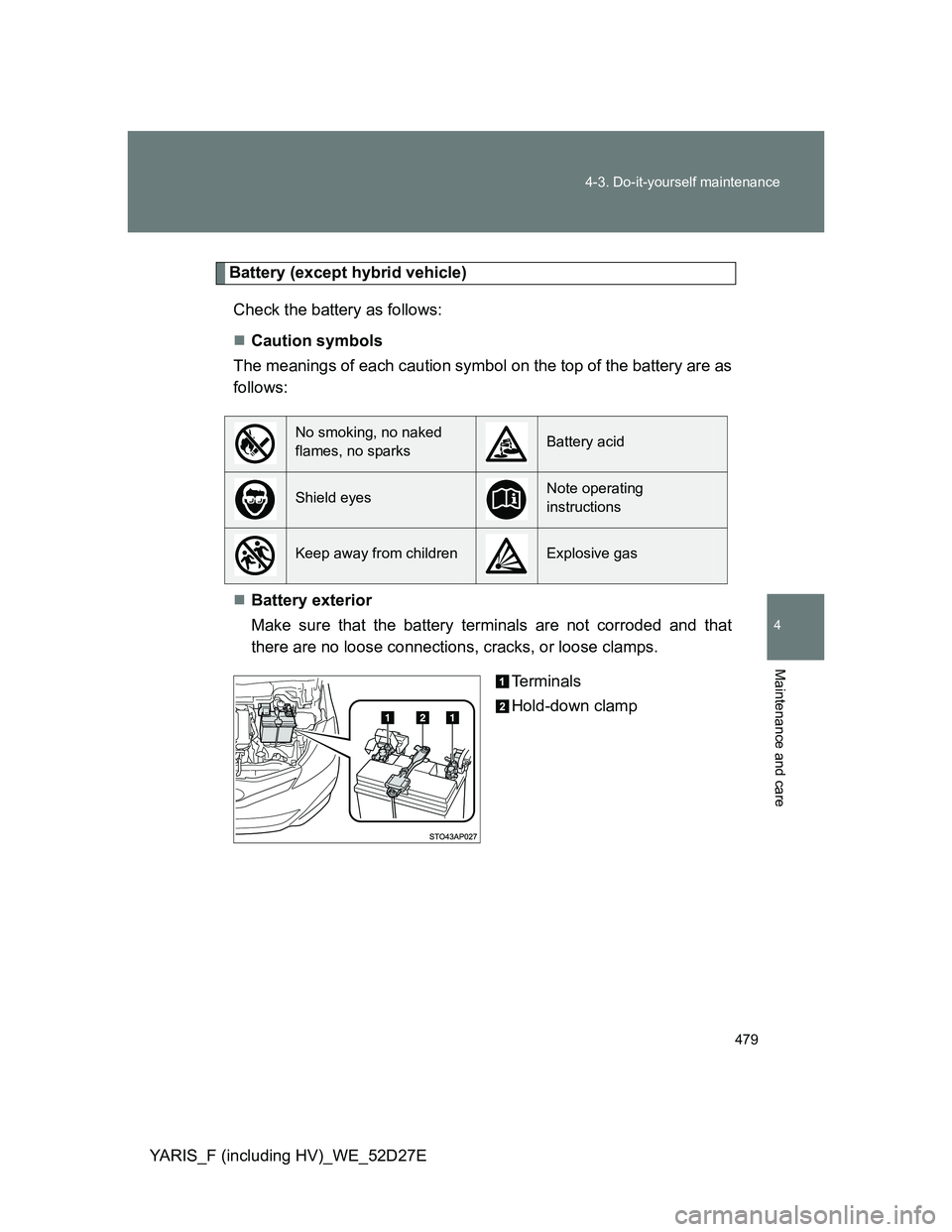
479 4-3. Do-it-yourself maintenance
4
Maintenance and care
YARIS_F (including HV)_WE_52D27E
Battery (except hybrid vehicle)
Check the battery as follows:
Caution symbols
The meanings of each caution symbol on the top of the battery are as
follows:
Battery exterior
Make sure that the battery terminals are not corroded and that
there are no loose connections, cracks, or loose clamps.
Terminals
Hold-down clamp
No smoking, no naked
flames, no sparksBattery acid
Shield eyesNote operating
instructions
Keep away from childrenExplosive gas
Page 480 of 700
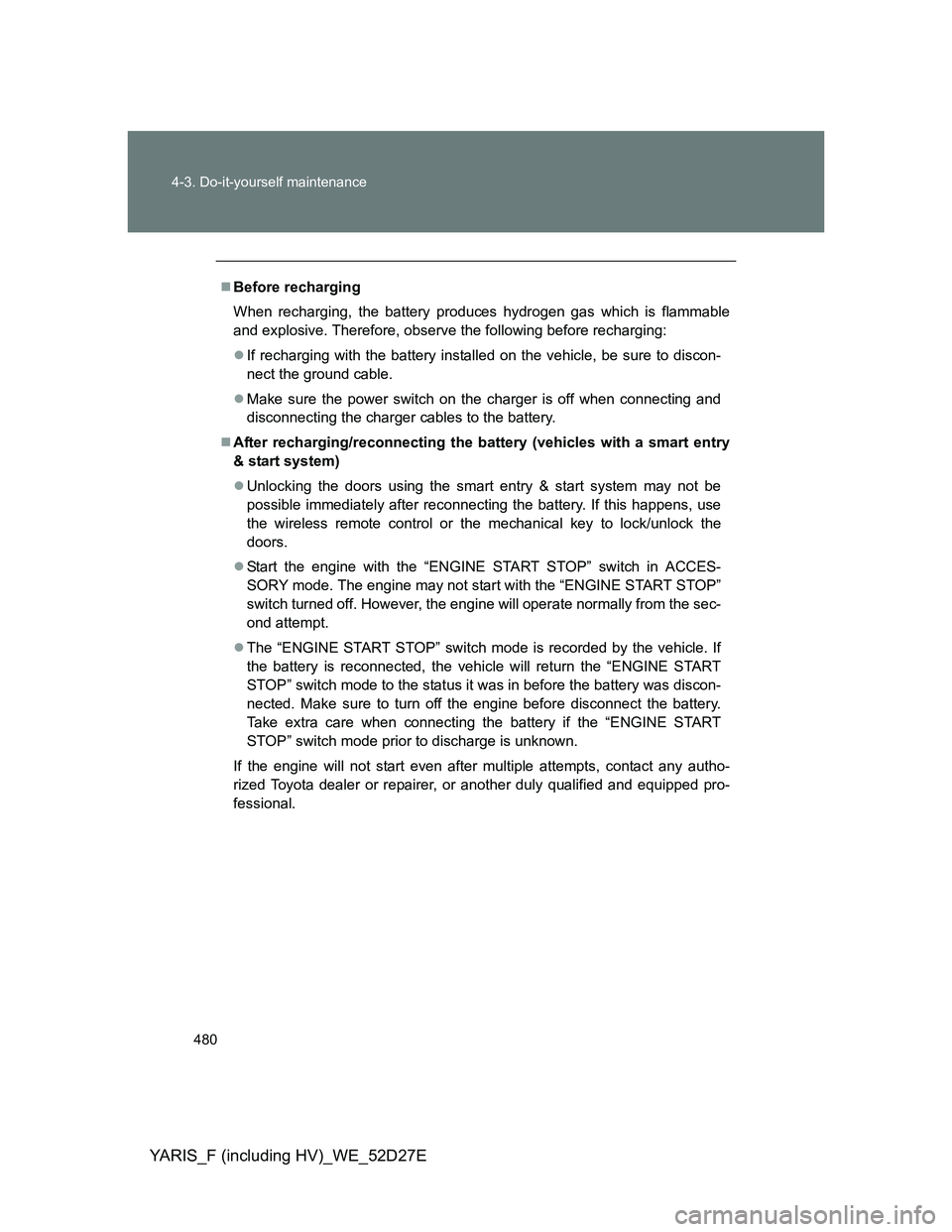
480 4-3. Do-it-yourself maintenance
YARIS_F (including HV)_WE_52D27E
Before recharging
When recharging, the battery produces hydrogen gas which is flammable
and explosive. Therefore, observe the following before recharging:
If recharging with the battery installed on the vehicle, be sure to discon-
nect the ground cable.
Make sure the power switch on the charger is off when connecting and
disconnecting the charger cables to the battery.
After recharging/reconnecting the battery (vehicles with a smart entry
& start system)
Unlocking the doors using the smart entry & start system may not be
possible immediately after reconnecting the battery. If this happens, use
the wireless remote control or the mechanical key to lock/unlock the
doors.
Start the engine with the “ENGINE START STOP” switch in ACCES-
SORY mode. The engine may not start with the “ENGINE START STOP”
switch turned off. However, the engine will operate normally from the sec-
ond attempt.
The “ENGINE START STOP” switch mode is recorded by the vehicle. If
the battery is reconnected, the vehicle will return the “ENGINE START
STOP” switch mode to the status it was in before the battery was discon-
nected. Make sure to turn off the engine before disconnect the battery.
Take extra care when connecting the battery if the “ENGINE START
STOP” switch mode prior to discharge is unknown.
If the engine will not start even after multiple attempts, contact any autho-
rized Toyota dealer or repairer, or another duly qualified and equipped pro-
fessional.